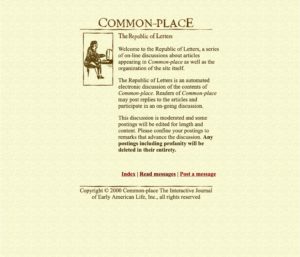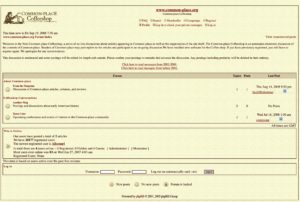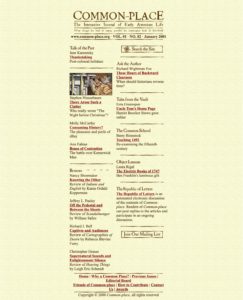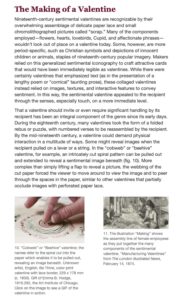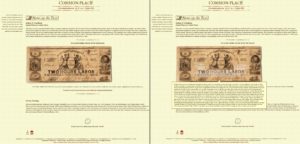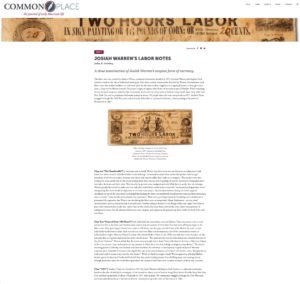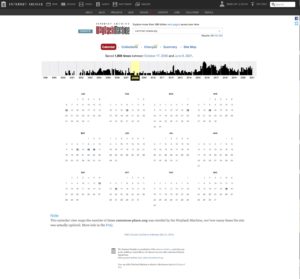Over the last two years, the Commonplace team has migrated our back catalog to a new URL and reorganized the content with a fresh, feed-based layout. While we are proud of this work, we also know that our readers have been waiting patiently for new content. I am pleased to announce that we are moving to phase two of our relaunch and will begin publishing original material this month. Look for new articles, review essays, and creative writing on various aspects of vast early America before 1900 to post every other Tuesday. If you have questions about submitting your work or want to pitch an essay, please reach out to commonplacejournal@gmail.com.
Before we move forward, it is a good time to look back on the history of Commonplace and its place in digital humanities over the last two decades. In September 2000, editors Jill Lepore and Jane Kamensky launched their new digital publication with a piece that introduced the site by answering the question, “Why a Common-Place?” (Figure 1) Aside from explaining that Common-place would attempt to walk the line between scholarly journal and popular magazine for American history before 1900, they specifically addressed their vision for one of the first exclusively on-line history journals. Even though “we have no film footage, no photographs, no videos or phonographs to load up with Real Audio or Real Player,” the editors did not want to see early American history left behind on the web in favor of modern history sites that featured a ton of bells and whistles. So, they concluded, other than “a few daguerrotypes (invented in 1839) Common-place won’t dazzle you with snazzy graphics,” but would focus instead on “bringing people together to discuss ideas” about early American history.
It is remarkable to see how many of the same concerns that publicly-facing scholarship wrestles with today informed the Common-place mission statement more than 20 years ago. How much should a digital humanities project focus on public interaction? Is this a conversation between scholars and the public or a primarily a venue for presenting an academic argument? How much and what sort of technology should be employed to disseminate research? Such questions often operate in tension as online projects are planned and executed. As Commonplace has evolved as a digital publication over two decades, it has grappled with these questions about audience engagement and the role of technology on the front and back end.
One desire of the early Common-place team was to reach out to the public and create a community to collectively engage in historical inquiry. The mission statement even introduced an online message board feature for readers to post replies to articles and “participate in an on-going discussion.” The message board, dubbed the Republic of Letters, never really got going and was retired within two years. (Figure 2) Rebranded as the Common-place Coffeeshop to serve as a welcoming place for readers to discuss articles, make announcements, or chat about anything related to early American history, the new forum likewise failed to become an online destination for community conversation. The Coffeeshop served its last cup in 2009. (Figure 3)
With these attempts to forge an online community sputtering, Common-place joined many digital publications in the aughts and created a blog. Jeffrey Pasley had been an occasional contributor to Common-place, using his Publick Occurrences column to situate his observations of contemporary politics in an early American context. His 2001 piece called “Losing one to the Gipper,” for example, discussed Ronald Reagan and Grover Norquist’s attack on the size of government to explain why Alexander Hamilton “has long been the least loved of the Founders.” (Figure 4) Little did he know what was coming a decade and a half later. Beginning in 2008 and continuing to 2015, Pasley converted his column into the blog Publick Occurrences 2.0. (Figure 5) His occasional musings covered everything from the election of Barack Obama to musical acts with historic names (such as 1990s power pop band Cotton Mather). With its more personal and light-hearted tone, the blog produced a different type of content, but also failed to generate the type of commentary or engagement to make it a jumping off point for a wider communal discussion.
The inability to inspire a broad digital conversation about early American history between academics and the public did not lessen the quality of the site’s scholarly work, but it did stand out as an unrealized promise of the project. In her William and Mary Quarterly article reflecting on digital humanities and early American studies, Sharon Block even gently noted that Common-place “did not quite succeed in creating an online community” in the way that some high-profile bloggers managed to do during the same years. She went on to explain that “in contrast to an earlier emphasis on producing charts, numbers, or statistics,” these attempts at engagement are part of a “new digital humanities [that] is marked by outreach and dissemination,” rather than the simple application of back-end technology.
Commonplace has been proudly and explicitly digital since its inception, but it has not always been comfortable with how to use technological tools as part of its outreach and dissemination. As we saw, its mission statement explicitly declared its intent to deemphasize visual and multimedia features. Original web designer John McCoy explained in 2004 that the editors requested that the site take its design inspiration from “seventeenth and eighteenth-century broadsheets—large sheets set in an unvariegated sea of tiny columns of text . . . in many ways the opposite of Web pages.” One result of this design plan is that much of the back catalog is largely textual, with only some graphic examples used for explanatory purposes. (Figure 6)
Over time, more visual and material culture articles appeared on the site, especially after Catherine Kelly became the editor of Common-place. Kelly explained in 2011 that the approach was to take traditional research, “reformatted for a different medium and with a different audience in mind. In other words, the crucial issues hinge less on technology per se than on translation.” There were attempts to expand this model. Joshua Brown’s Flash-based graphic novel “Ithaca” is one notable example (Figure 7), as is Christina Michelon’s “Touching Sentiment,” an article analyzing the tactility of nineteenth century valentines that includes video clips of an 1875 valentine being opened and a GIF of a beehive card being pulled out. (Figure 8)
Not every plan to utilize new multimedia tools has been as successful in the long run. Nine years ago, I wrote a piece about a labor note issued by Josiah Warren’s Modern Times, a planned community on Long Island in the 1850s. Conceived as part of a new “Notes on the Text” column that featured items housed at the American Antiquarian Society, I digitally marked up the note so that a reader could interact with the item through my nonlinear narration. Using a plugin called qTip², a reader could come to the page, scroll their cursor over a section of text or image on the labor note and up would pop a paragraph that I had written analyzing that portion of the bill and its place in the history of capitalism, labor radicalism, and utopian communities. (Figure 9) This was a cool idea for a piece in late 2012. It engaged the public and allowed the viewer to control their experience with the text. However, it turned out to be hard to read and maneuver on mobile phones. The bigger problem was that the designer of the qTip² plugin stopped maintaining it in 2016 and the page became functionally inoperable on most browsers shortly thereafter. The current low-tech version of the page shows the labor note followed by explanatory paragraphs corresponding to different portions of the image. (Figure 10)
However, hoping to avoid front-end tech issues doesn’t save you from back-end problems. Publishing an electronic journal necessitates the flexibility to keep up with changing technology standards and Commonplace has been pushed to alter its platform several times in the last 20 years. When Common-place launched in 2000, John McCoy built each page individually in HTML to resemble an eighteenth-century broadsheet. This labor-intensive project solved a short-term design preference, but it also hindered the long-term stability of the site as browser and operating system updates meant that even minor issues could cause problems and lead to broken links, features, or pages. Hoping for standardization and more flexibility, the site adopted a new XHTML/CSS design in 2004 (for a reminder of how long ago this was in web years, an announcement at the time reminded Common-place users to upgrade their browsers because Netscape 4.x and Internet Explorer 5 for Windows would not render CSS properly). This technology too began to show its age and in 2015, the site was completely redesigned on WordPress by a new editorial team at the University of Connecticut. (Figure 11) Unfortunately, the plan to fully utilize this stability and migrate the pre-2015 material to the new platform was not completed; by early 2019, forty percent of the Common-place back catalog was missing or inaccessible.
Luckily, this material was not completely lost. As part of a transition to a feed-based model and a new WordPress platform in 2019, it was recovered using the Internet Archive Wayback Machine and a bit of detective work. The one gap in the back catalog was Jeff Pasley’s Publick Occurrences 2.0. The blog updated sporadically and separately from the rest of the issue-based articles, so its contents were not contemporaneously preserved. Likewise, the Wayback Machine only takes snapshots, and often months can go by between those backups (May 16-Sept 13, 2008). (Figure 12) There is something of a sad irony that a feature of the site created to foster public engagement is the one incomplete part as the project shifted to a new model meant to make it easier for the public to engage with the site’s content. That tension between dissemination and technology reared its head again.
The scale of reconstructing the site, reformatting the back catalog, and remaking it with a feed-based organizational structure was so great that it also contributed to the dramatic step of moving the site from www.common-place.org to a new URL, commonplace.online. (Figure 13) Rebranding a 20-year-old digital humanities site is not a step taken lightly and it highlights the difficulty in keeping up with changing technology trends and standards. But it is more than that.
Many digital history projects are conceived and designed to utilize particular technological tools and present discrete data and analysis. As such, these projects spend ample time pinpointing the best approach to disseminate their content and considerably less time thinking about their scalability and durability. This makes sense given the narrow scope of the projects and the reality that the resources and time required to build something with an indefinite shelf life are not often available. While corporate creators of databases spend time and money to make their products scalable in the anticipation of future expansion, growth, and revenue, many scholarly practitioners of digital humanities eschew this profit motivation and don’t spend enough time planning for the distant future of their work. Aarthi Vadde notes that “few scholars working in the humanities today will immediately recognize scalability as a virtue. Some may even see it as a vice.” However, if scalability is merely, as Vadde explains, the “ability of a system, network, or project to handle growth without changing its governing principles,” it needs to be a central component of any digital project that desires longevity. Allowing a project to grow or even persist over years and decades means planning for technological realities that don’t currently exist. This is not a new concept for scholars of public-facing projects, but I do think the example of Commonplace is a useful one when considering what it means for digital humanities moving forward.
I want to close by highlighting a 2016 essay by Cameron Blevins from Debates in the Digital Humanities. He writes that many historians fall into the trap of framing “digital methodology in terms of its future potential.” Talking about what technology might soon do may seem cutting edge, but it obscures how digital projects spend so much time on their plans for data visualization, dissemination, and outreach that they sidestep academic argumentation. This is a common debate in digital humanities today, but I want to argue that Commonplace demonstrates that there is also counter narrative. Online projects with engaging subject matter also need to think more about the future. Digital Humanities is inherently material and merely creating smart front-end content won’t sustain your project in the long run. There is not one answer or model for how to best keep pace with the changing technological landscape over multiple decades, but it is vital for practitioners of Vast Early American projects to think about flexibility and scalability. Time spent preparing for evolving internet standards and a future that can’t yet be fully imagined is certainly a better option than trying to go back and retrofit a project years after the fact.
This article originally appeared in September, 2021.
Joshua R. Greenberg is the editor of Commonplace: The Journal of Early American Life. He is the author of Bank Notes and Shinplasters: The Rage for Paper Money in the Early Republic (2020) and Advocating the Man: Masculinity, Organized Labor, and the Household in New York, 1800-1840 (2008). He taught at Bridgewater State University for many years. On Twitter @joshrgreenberg.




